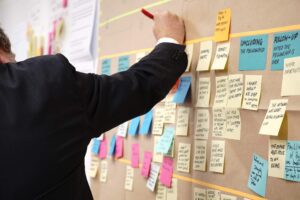Exploring the Power of Agile User Stories
While the motto “The customer is always right” sparks debates in the retail world, it holds valuable wisdom for Agile projects. Notably, customer satisfaction takes the top spot in the Agile Manifesto’s list of priorities. In the Agile methodology, incorporating user feedback into the development process is standard practice. Agile teams wholeheartedly welcome this external perspective to ensure alignment with customer needs and deliver the most suitable end product.
At the core of Agile work structure lies a thorough exploration of the customer perspective, typically achieved through the creation of user stories. This article delves into the world of user stories—defining what they are, providing insights into how to craft them effectively, and examining both their advantages and disadvantages. Additionally, we will share an Agile project plan template to empower you in efficiently managing your Agile projects from inception to completion.
What Are User Stories?
In the realm of Agile workflows, a user story represents a concise unit of work. It serves as a brief written explanation, detailing a specific user’s need and how it can be met. The key to an effective user story lies in its avoidance of jargon, ensuring it is written in accessible language that paints a clear picture of the user’s requirements. Technical intricacies are intentionally left out at this stage, to be addressed later in the process.
Each user story encapsulates a short-form request, intended to be completed within a single Agile iteration or sprint, usually lasting one to two weeks. To gauge the complexity of user stories and accurately estimate the time required for each request, teams utilise story points as a helpful measure.
When multiple user stories are grouped together, they form what is known as an epic. Managing the epic falls under the responsibility of the product owner, although any member of the Agile team can contribute to its creation.
Comparing user stories to use cases, the former is less detailed. A user story provides a brief description of a planned action item, whereas a use case tends to include additional sections, such as required conditions, various user paths within the product, and workflow diagrams.
You can learn more about how the concept of user stories fits into the other agile principles here.
What Are The Benefits of Writing User Stories?

User stories play a pivotal role in Agile projects, offering a myriad of benefits, including:
- Simplified Format: User stories are composed in straightforward and easily understandable language. This simplicity eliminates confusion, enabling a clear grasp of the customer’s needs and desires.
- Increased Flexibility: The absence of technical intricacies in user stories allows them to be adaptable to changing situations. They can be moulded and adjusted to accommodate evolving project requirements.
- Improved Collaboration: By aligning team members towards a shared goal, user stories facilitate better teamwork and foster seamless collaboration with other project stakeholders.
Despite the significant advantages user stories bring to Agile projects, product managers must also consider and address any potential disadvantages that may arise.
What Are The Disadvantages of Writing User Stories?
To ensure the effectiveness of user stories in Agile projects, it is crucial to be mindful of potential pitfalls. Here are a few to watch out for:
- Incomplete Stories: While informal language is encouraged, some user stories may turn out to be overly vague, lacking essential details. It is vital to include all necessary information to avoid confusion and ensure a comprehensive understanding of the requirements.
- Insufficient Time: Crafting a well-defined user story demands ample time and effort. Conducting extensive research and maintaining regular communication with stakeholders are essential steps that should not be overlooked or rushed.
- Narrow Vision: User stories typically focus on individual requirements, which can make it challenging to scale and lose sight of the broader project picture, such as the overarching epic. Strive for a balanced approach that considers both the specific needs and the larger context.
Before embarking on your user story, take the time to identify potential risks or disadvantages that may arise and outline strategies to counteract them effectively. By doing so, you can maximise the benefits of user stories while minimising any potential drawbacks in your Agile journey.
How Do I Write User Stories?
1. Create Your Acceptance Criteria
The “Definition of Done” encompasses the specific criteria that must be met to deem a user story as complete. By defining clear acceptance criteria, you can effectively use them as a checklist to ensure the successful fulfilment of the user story.
2. Determine User Persona
Thoroughly explore user insights through various research methods such as surveys, focus groups, and engagement with user forums. Analyze the gathered data meticulously, seeking patterns and trends to identify and define your key personas.
3. Make User Tasks
To enhance manageability, break down your story into multiple tasks. For complex requirements, consider adding subtasks as well. Ensure each task is accompanied by detailed descriptions, fostering alignment within your team regarding the specific requirements of each task.
4. Map The Tasks To Stories
Leverage user story mapping to organise work in larger processes. Employ this approach to structure your stories as ordered steps, creating a clear and logical flow of tasks.
5. Get Feedback
Engage in meaningful conversations with users and potential customers to understand their needs and desires. Seek their opinions on current products and gather suggestions for new features. Integrate this valuable feedback into your user story, ensuring it aligns closely with the user’s perspective.
You can learn more about getting valuable user feedback by closing the customer feedback loop here.
What Makes A Good User Story?

Once you’ve crafted your user story, the next step is to evaluate its effectiveness. Agile teams utilise the INVEST acronym as a guide for assessing user story quality. Here’s what INVEST stands for:
- Independent: Ensure the user story remains self-contained and unlinked to others, allowing it to be worked on independently in any order.
- Negotiable: Keep the user story flexible enough to allow for constructive negotiation between the customer and product owner.
- Valuable: Determine the value the user story brings; if no significant value is found, reconsider completing it.
- Estimable: It should be possible to estimate the time required to complete the user story, enabling efficient time management.
- Small: The user story should be of a manageable size, achievable within a single sprint.
- Testable: Ensure the user story can be adequately tested in line with quality assurance standards.
If a user story fails to meet the INVEST criteria, it should be rewritten or excluded from the epic. Conversely, if it meets the criteria, your team can proceed with confidence. To monitor progress and maintain alignment, schedule daily Agile meetings to track their advancements and ensure timely completion of the user story within the sprint timeframe.
How Should I Use User Stories?
After a user story has been written, it’s time to seamlessly integrate it into your workflow. Typically, the user story is authored by the product owner, product manager, or programme manager, and then submitted for review.
During a sprint or iteration planning meeting, the team collectively decides which stories they will take on for that particular sprint. This meeting serves as an opportunity for in-depth discussions about the requirements and functionalities each user story demands. It encourages the team to explore technical and creative possibilities for implementing the story effectively. Once a consensus is reached, the agreed-upon requirements are appended to the user story.
Another crucial step in this meeting is scoring the user stories based on their complexity or estimated time for completion. To make accurate estimations, teams often use methods like t-shirt sizes, the Fibonacci sequence, or planning poker. It’s essential to size each story in a way that ensures it can be completed within a single sprint. As the team speculates on each story, they break up larger stories that may exceed the sprint’s completion horizon, ensuring a balanced workload.
What Are The 3 C’s Of User Stories?

In 2001, Ron Jeffries proposed the Card, Conversation, Confirmation model for user stories as a fundamental concept within extreme programming (XP), considering them critical elements of the XP Circle of Life. Let’s explore the three key aspects of user stories defined in this model.
1. Card
User stories are typically written on index cards, keeping them concise and focused. The manual writing exercise ensures that the cards contain just enough information to identify the requirement and aid comprehension. These cards represent the individual requirements and serve as valuable planning tools. Additionally, they can include supplementary notes such as priority or estimated cost.
The Product Owner, after finalising the user story for a specific sprint, hands over the user story card to the developers. The standard format for writing user stories on these cards follows this structure: “As a [user type], I want / need [goal] so that I can accomplish [justification/business value].” This format encapsulates the essence of the user’s need, making it clear and actionable for the development team.
2. Conversation
The card serves as the initial step in formulating the user story, but the process doesn’t end there. Further discussion and refinement are essential before communicating the requirement to the developers. This crucial step takes the form of collaborative conversations involving developers, Product Owners, Scrum Masters, and stakeholders. Through these conversations, a shared understanding of the requirement emerges, contributing to the successful development of the product.
These conversations occur incrementally over time, commencing with story estimation during release planning and continuing during the sprint planning meeting when the story is selected for implementation. While these discussions are primarily verbal, supporting documents can be used to supplement and reinforce the understanding of the user story.
3. Confirmation
Despite comprehensive conversations, there may always be a lingering doubt regarding the precise user story requirement. To address this, we turn to the third C of user stories: confirmation. Confirmation is achieved through the formulation of acceptance criteria, which act as the essential requirements for testing the created product against defined standards.
Acceptance criteria are primarily crafted by the Product Owner and further refined during backlog refinement. Developers then implement these acceptance criteria or acceptance tests. The resulting increment must align with the acceptance tests, signifying that the feature has been correctly implemented. At the end of the iteration, developers demonstrate the story’s completion by satisfying the acceptance criteria, marking confirmation achieved.
With all three Cs of user stories (Card, Conversation, and Confirmation) completed and satisfied, the created feature is deemed complete and ready for release. This process ensures clarity and accuracy in the user story, paving the way for successful product development.
The Fourth C (Context)
In some cases, a fourth C, representing context, is added to user stories. This additional aspect contributes to a more comprehensive understanding of the user story and its interrelation with other stories. It aids in making informed decisions regarding the sequencing of user stories and how they could be grouped together within a Timebox or Increment. To effectively address all Four Cs (Card, Conversation, Confirmation, and Context), facilitated workshops are commonly employed by the team. These workshops foster collaborative progress and ensure a well-rounded approach to crafting user stories.
What Are the Phases of Agile User Story Development?
The Feasibility Phase
The objective of this phase is to assess the project’s feasibility from both business and technical standpoints. During this stage, a maximum of ten Epics are formulated to encapsulate the top-level business objectives and goals. These Epics are written as concise statements, following the User Story format, to provide a clear overview of the project’s high-level vision.
The Foundations Phase
The primary focus of this phase is to establish a robust and enduring foundation for the project. To achieve this, User Stories are written at a high level, accompanied by their acceptance criteria, serving as placeholders for consideration in a subsequent Delivery phase. Additionally, User Stories for Non-Functional Requirements, which encompass aspects like security, availability, performance, certification, and compliance, are also created. These non-functional requirements are essential as they may influence future design decisions.
All of these User Stories play a vital role in clarifying the project’s scope, priorities, and estimates. During this phase, a Prioritized Requirements List (PRL or Backlog) is compiled to meticulously record all the User Stories, including their priorities and requesters. This comprehensive list will serve as a valuable reference point throughout the project.
The version of the Prioritized Requirements List that emerges at the end of the Foundations phase can be used as a fixed reference point or baseline to effectively manage scope creep, ensuring project success.
The Delivery Phase
The criteria for considering a User Story as “Done” include fulfilling all the acceptance criteria and obtaining formal acceptance from the solution owner.
The Delivery phase of the project is composed of fixed-period Timeboxes or Sprints, typically spanning 2-4 weeks. During each Timebox, an agreed-upon list of User Stories will be addressed. It is at this stage that the User Stories will undergo in-depth discussions regarding lower-level details and their acceptance criteria. Addressing these details now enhances accuracy and relevance to the evolving solution.
This process may reveal the need to decompose a User Story into two or more smaller stories, which may carry different priorities or be postponed for later Timeboxes. Throughout the Timebox, testing is conducted to assess the completion of each User Story based on its acceptance criteria.
If by the end of the Timebox, a User Story is deemed incomplete, a decision must be made whether to carry it forward to a subsequent Timebox or postpone it for later consideration. This iterative approach allows for continuous improvement and adaptation throughout the project.
How Should I Manage The Progress of User Stories?

Prioritise
To determine the relative importance of each User Story, their priority should be noted, often using the MoSCoW Prioritisation technique. Ensuring higher priorities can be justified is crucial, and in this regard, the Project Manager or Business Analyst plays a pivotal role in challenging the Business Representatives.
In the event of new requirements arising after the project has commenced, the Business Analyst investigates whether they pertain to additional details for existing User Stories. If that is the case, the User Story and Prioritized Requirements List (PRL) might be updated accordingly. However, if these new requirements broaden the solution’s scope, they are escalated to the Business Representatives. The Business Representatives then decide on their inclusion, priority, and whether other User Stories should be deprioritized to accommodate them. This careful consideration ensures that the project remains on track and aligns with changing needs.
Maintain the Prioritized Requirement List (PRL)
Regularly updating the Prioritized Requirements List (PRL) is essential to keep it accurate and relevant throughout the project’s lifecycle. The updates serve multiple purposes, including capturing new User Stories, adding further details to existing ones, reflecting changed priorities, tracking progress, and marking User Stories as Done.
Both the Project Manager and Business Analyst often share the responsibility for maintaining the PRL, ensuring that it remains up-to-date and serves as a valuable reference for the project’s development and management.
How Should I Track The Progress of User Stories?

Maintaining a high degree of visibility is crucial throughout an Agile project. To effectively track User Stories once the project is in progress, various tools and techniques can be employed.
Story Maps
To establish and visualise the association between Epics and the underlying User Stories, a hierarchical record is maintained. Story Maps serve as valuable tools for planning and ensuring that User Stories are appropriately assigned to the relevant Epics.
The PRL
Regular updates to the Prioritized Requirements List (PRL) are essential, and it should be easily accessible to all stakeholders.
Story Boards
During the execution of a Timebox, the individual User Stories are dynamically rearranged on the Story Board to reflect their current status. They are organised into categories such as “To Do,” “Ready to Develop,” “In Progress,” “Ready for Sign Off,” and “Done.”
Stand-Ups
These daily meetings, known as Stand-Ups, provide an opportunity for individual members of the delivery team to share updates on the following:
- Progress made on any of the User Stories since the previous Stand-Up.
- Planned tasks for the period until the next Stand-Up.
- Any encountered issues or “Blockers” that might require assistance from others.
User Story Template
In the Agile framework, user stories adhere to a straightforward template, providing essential details about a specific requirement:
- Who wants something?
- What do they want?
- Why do they want it?
The following template is widely used and captures these elements effectively:
“As [persona], I want to [action], so that I can [benefit].”
Each user story includes a user persona, the action they desire or the ability they seek, and the benefit they aim to achieve. For instance, consider this example of a design team lead user story:
“As a design team lead, I want to organise assets so I can keep track of multiple creative projects.”
User Story Example
User Story Examples:
- As Max, I want to invite my friends, so we can enjoy this service together.
- As Sascha, I want to organise my work, so I can feel more in control.
- As a manager, I want to be able to understand my colleagues’ progress, so I can better report our success and failures.
These user stories represent specific desires and goals from the perspective of different personas (Max, Sascha, and a manager). Each statement captures the intent of the individual and the benefits they aim to achieve through the requested actions.
Overview
User stories hold a pivotal role in the success of agile software development projects. These concise and collaborative narratives focus on end-users’ needs and perspectives, facilitating clear communication and efficient workflows. Adhering to the “INVEST” criteria ensures that user stories remain valuable, independent, negotiable, estimable, small, and testable, streamlining the development process.
It’s crucial to recognise that user stories go beyond being mere requirements; they are the driving force behind building products that genuinely resonate with users and deliver exceptional value. As you embark on your agile journey, prioritise user stories as a central element in your development approach, and witness how they empower your team to create remarkable, user-centric solutions.
If you’ve enjoyed this post, we’d recommend diving into the following other posts in this Agile series:
- An Introduction to The Agile Methodology
- Themes, Epics and User Stories – The Core Components Of Agile
- Embracing Agile Team Dynamics
- What is SAFe Agile and Why Should I Use It?
- What is Waterfall Development?
- What is Lean Development?
- What is Scrum?
- A Deep Dive Into Epics
- Exploring The Power of User Stories
- How Can I Use Personas?
- Decoding Agile Estimation (Story Pointing)
- Agile Transformation: How Can My Business Start Using Agile?
- The Spotify Approach To Agile Development
- What Is Agile Portfolio Management?
- Agile Glossary
- Agile Statistics







